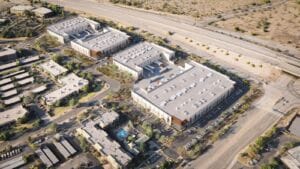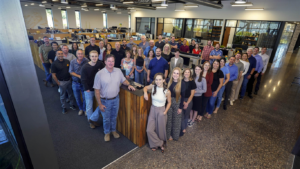Developers are taking action in Phoenix’ industrial market, constructing on land that has been held in wait. This is according to the first quarter industrial report released by Cushman & Wakefield of Arizona, Inc.
“Mid-sized spaces are in short supply and developers are stepping up to fill the need,” says Jackie Orcutt, Senior Director with Cushman & Wakefield. “The Deer Valley and Southeast Valley submarkets are particularly active with planned projects and construction. Developers are benefitting from significant pre-lease commitments.”
Throughout the Metro Phoenix area, nearly three million square feet of space are under construction. Approximately 1,855,179 square feet have already been completed and delivered to the market in 2015. The majority of the new space delivered in first quarter is found in Southwest Phoenix, known for its sizable warehouse/distribution facilities. “Developers such as Trammel Crow will be building three projects in the Valley, one in Gilbert, one in Avondale and the other in Deer Valley,” says Orcutt. “These are experiencing some nice pre-leasing activity.”
Overall vacancy of industrial sits at just 12.5 percent, up slightly from a year ago because Metro Phoenix added approximately 6,457,851 square feet to its inventory in 2014. Year-to-date net absorption totals 904,600 square feet, keeping pace with the rate of absorption from last year. The largest lease signed this year was Tuesday Morning’s commitment for 593,600 square feet at the Liberty Logistics Center at 563 S. 63rd Ave.in Southwest Phoenix on Interstate 10. This lease was posted following the close of first quarter, so will appear in second quarter figures.
“Known for its large users, the Southwest Valley is now seeing strong demand from the smaller users,” says Orcutt. “Many of these users are tied to the housing industry, which indicates a confidence in the resurgence of homebuilding. While demand from these users is very positive, the Southwest area has overbuilt its facilities for users 200,000 square feet and larger. Several new projects of that magnitude were recently constructed and we now have 15 properties available that can accommodate 200,000-square-foot users. There simply hasn’t been the demand to fill them. Absorption of those larger facilities will take time and patience.”
Rental rates have responded to market conditions, rising in areas of low supply and remaining low in categories of overabundant inventory. “The larger users can still exercise leverage in their transactions, but submarket pockets with very low vacancy are commanding rate increases,” says Orcutt. Southeast Valley submarkets of Chandler and Gilbert have been particularly popular with highly specialized tenants, such as pharmaceutical companies. The demand from tenants who want space south of US 60 and east of the Loop 101 has been strong. The Southeast Valley cities of Chandler, Gilbert and Mesa now have more than a million square feet under construction. “This is a remarkable event since the vast majority of industrial construction for the past few years has been focused in the big-box Southwest Valley,” according to Orcutt.
Leasing activity for the first three months of 2015 has been strong and is anticipated to remain so for the rest of the year. “Our economy is strong. Local users are growing and we continue attracting companies from outside the state. We will keep our eye on California to see if users from that area are drawn to Arizona in the wake of the state’s water crisis. If that situation is not resolved, it may create a new wave of demand in Phoenix,” says Orcutt.



